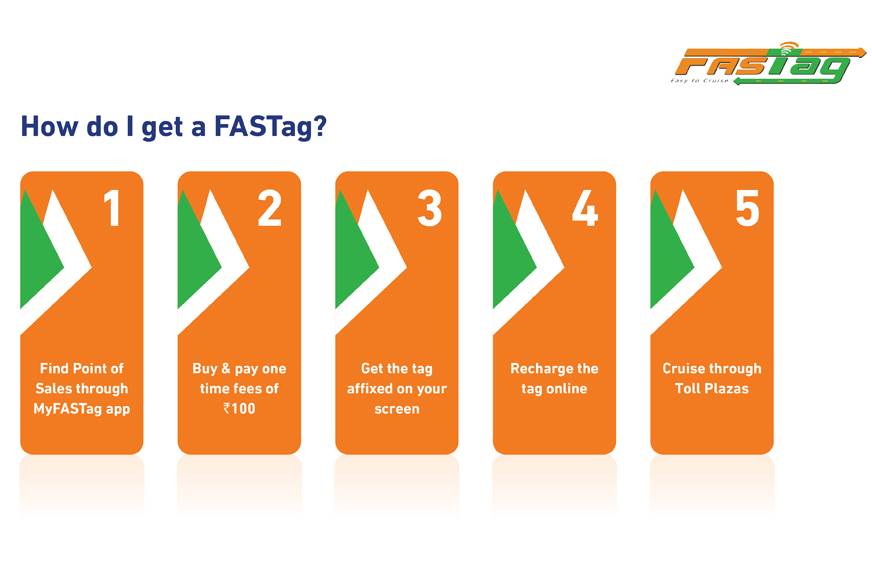
As part of the Indian government’s ‘Digital India’ initiative, electronic toll collection through the implementation of FASTag is set to become mandatory from December 1, 2019 on all national highways. The digital system has been developed by the National Payments Corporation of India (NPCI) and is based on the National Electronic Toll Collection (NETC) programme.
The move is not only being positioned as a measure to further bolster digital payments throughout the country, but also as an effective means to decongest highways. While the bigger picture sure is promising, what will the shift towards cashless toll payments entail for the end user? We take a closer look.
What is FASTag and how does it work?
FASTag is a passive device, affixed to a vehicle’s windscreen, which works on the principle of radio frequency identification (RFID) and enables cashless toll payments without requiring the vehicle to stop and wait in a queue. When a motorist drives a vehicle equipped with the RFID tag through a dedicated toll plaza lane, aFASTag reader automatically detects the tagged vehicle and charges the appropriate amount from a linked account, while the vehicle is still in motion. The motorist gets intimated about the toll deducted via SMS on his registered mobile number.
Where can the FASTag be used?
FASTags were introduced over four years ago and until now, their usage has been optional. At the moment, they can be used at over 500 toll plazas across the country, including all national highways as well as some state highways.
However, beginning December 1, FASTags will become mandatory for all four-wheeler passenger vehicles and all commercial vehicles including buses, trucks, tractors and construction machinery at all national highways. This means that all lanes at national highway toll plazas will only allow electronic toll collection through FASTag, with just one lane reserved for collection through cash.
NitinGadkari, Union Minister for Road Transport and Highways, recently revealed that almost 90 percent toll plazas are ready with FASTag infrastructure and only some new toll plazas will face teething issues.
What are the benefits of FASTag?
The implementation of FASTag can help alleviate numerous problems. Since coming to a complete halt at the turnpike for cash transactions is not required, major bottlenecks on highways are avoided. Commuters save time that they otherwise would have wasted waiting in long queues. The expeditious passage of vehicles through toll plazas also helps in reducing fuel consumption and ultimately curbing air pollution. Moreover, the whole system promotes digital payments, reduces cash handling and increases transparency.
As an added incentive, motorists paying toll through FASTag at any national highway are promised a 2.5 percent cashback till March 31, 2020.
How can a FASTag be acquired?
In the run up to the December 1 deadline, new passenger vehicles nowadays are already equipped with FASTags. Existing vehicle owners can purchase the RFID tags from more than 20 NETC authorised member banks (the complete list of which is available here). Additionally, they are also retailed through point-of-sales (POS) locations at select toll plazas, the NPCI website, Amazon website and the official MyFASTag app on the Google Play Store.The price of a FASTag is fixed at Rs 100, but the threshold balance to be loaded in the FASTag account will differ as per the issuer’s transaction rules.
To further facilitate adoption of the new technology, Gadkarihas directed the National Highways Authority of India (NHAI) to issue free FASTags till December 1. In a recent press conference, he said, “Free FASTags will be available at all points of sale of the NHAI and they will also be made available at other places having a high potential of sales.” Consequently, security deposit for each of the tags issued fromdesignated outlets till November end will be borne by the Ministry of Road Transport and Highways.
Some of the documents required for obtaining and activating a FASTag include the vehicle’s registration certificate and the owner’s photograph and other identity proofs.
Moreover, a FASTag is vehicle specific and is linked to the car’s registration. As such, once assigned to a vehicle, it cannot be transferred to another vehicle.The tag has a validity of 5 years.
How can a FASTag be recharged?
A FASTag can either be linked to a prepaid account or to the customer’s savings/current account. The former requires the tag to be topped up as per the owner’s usage. This can be done through any UPI-enabled smartphone app and also through the MyFASTag app. Additionally, users have the choice of recharging their accounts from the issuer bank’s website using debit cards, credit cards and net banking.
The NETC digital platform has already proved to be quite promising over the past four years. In September this year, an average of 9.7 lakh transactions were processed daily through FASTags across the country. Since the programme began, over 56 crore FASTag payments amounting to Rs 13,449 crore had been processed till the end of September 2019.
from Autocar India https://ift.tt/2D89cMV
via IFTTT

No comments:
Post a Comment